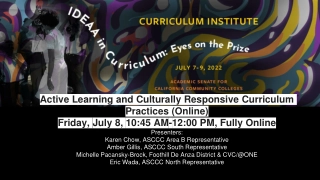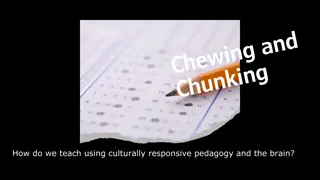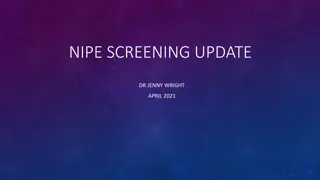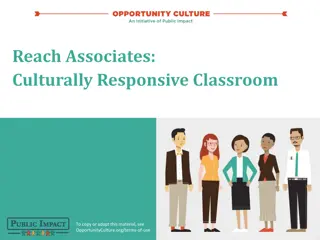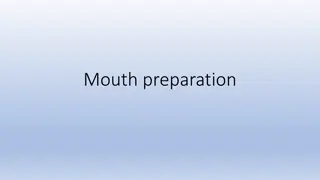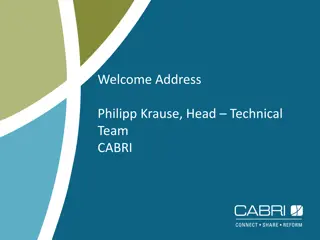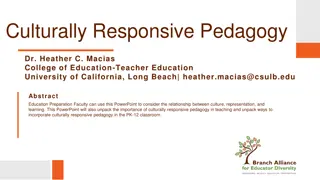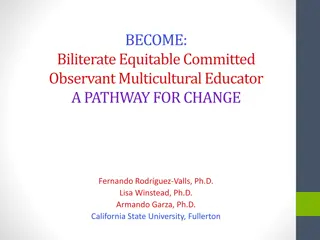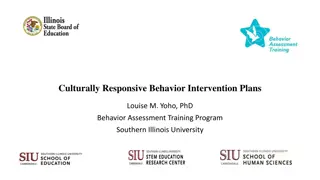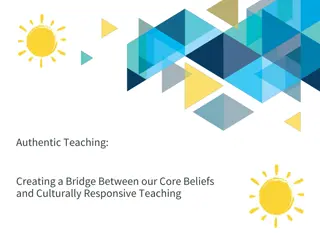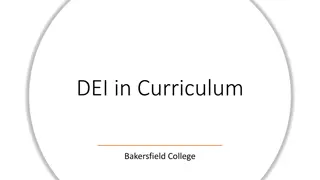Culturally Responsive Teacher Preparation: A Critical Examination
This paper discusses the impact of preservice teacher dispositions and cultural/language competency courses on novice teachers' beliefs and implementation of culturally responsive teaching. It highlights the need for teachers to possess intercultural competence and addresses the cultural gap in teacher education programs. The presentation shares data on preservice teachers' attitudes and experiences, emphasizing the importance of addressing cultural mismatches in education to promote academic and social success for all students.
Download Presentation

Please find below an Image/Link to download the presentation.
The content on the website is provided AS IS for your information and personal use only. It may not be sold, licensed, or shared on other websites without obtaining consent from the author. Download presentation by click this link. If you encounter any issues during the download, it is possible that the publisher has removed the file from their server.
E N D
Presentation Transcript
No Teacher Left Behind: A Culturally responsive lens on the necessary strands for teacher preparation Joy Broughton Nicholas Catania Ashley White Dr. Jeannie Kleinhammer-Trammil University of South Florida
Rationale Present research regarding the impact of preservice teacher dispositions and cultural / language competency courses effect on novice teachers beliefs and implementation of culturally responsive teaching, shows limited continuity. Today s student demographics represent diverse cultures from around the world, yet the majority of teachers represent a U.S. monolingual white culture. More specifically, Culturally and linguistically diverse (CLD) students experience less academic and social success in U.S. public education institutions. This study contributes to the literature through exploring preservice teacher attitudes and beliefs through survey and interview data, and development of intercultural competence over a year-long immersion. Original beliefs, process of changing beliefs, and post-experience reflections in a full cultural immersion while completing their first year teaching. As a result issues of equity in curriculum, instruction, and referral to special education continue to arise. Of many plausible reasons is the lack of knowledge preservice teachers possess upon obtaining instructional positions that require the education of CLD students. In specific connection to the University of South Florida s Special Education Preservice Program, coordinators notice a continuing inefficiency regarding students ability to demonstrate competency regarding cultural and linguistic instructional practices. These and other issues serve as motivating factors for conducting current research. In attempts to bridge this cultural gap, teacher education programs, sometimes, provide preservice teachers with courses on diversity and multicultural education in combination with with local field experiences.
Abstract Presenters will share collective data regarding preservice teachers attitudes and beliefs (scale) as well as personal experiences (interview) that impacted noted dispositions. These data will inform overarching issues of cultural and linguistic mismatches between special education teachers and their diverse students as well as resulting shortages in academic and social successes for outlying student populations. Teacher educators, collegiate faculty, educational researchers, and policymakers in the audience will be encouraged to engage in discussion on data implications next steps for longitudinal study components of high-quality teacher preparation necessary to for prevention of disproportionate ESE representation
In her most recent book, Gay (2010) outlines a multifaceted approach to culturally responsive education. Factors include the acknowledgement and inclusion of prior experiences, community settings, cultural backgrounds, and ethnic identities of teachers and students . Gay explores and debunks ineffective notions regarding education for the advocacy of a holistically beneficial model. Cultural Responsiveness
Ladson-Billings (2005) explores the contrast between teacher and student populations. As the diversity of school aged children increases, the diversity of educators decreases. Plausible reasons exist ranging from increased career opportunities to increased certification mandates. Deep and long standing issues between races contribute to problematic education of marginalized students. Diversity and Education
Among the factors identified by Darling-Hammond (2014), she includes explicit strategies to help students confront their own deep-seated beliefs and assumptions about learning and students and to learn about the experiences of people different from themselves . Among the many facets that make for a cohesive and effective clinical education program is the implementation of instruction that allows preservice teachers to develop a personal and instructional understanding of diverse student populations. Clinical Preparation
Consider Feiman-Nemsers (2001) framework for teaching wherein a content-rich and learner-centered approach is favored over a psychological ...stage model (Lucas & Villegas, 2013). Such a structure focuses on longitudinal instruction, serving as a fitting teaching frame for the organization of central ELL teaching tasks related to linguistically responsive teaching. (Lucas & Villegas, 2013). This and other research highlights the importance of examining preservice education programs successful preparation of prospective educators for ELL instruction, including, but not limited to disposition analysis, logical teaching frameworks, and redirective course and fieldwork. Linguistic Responsiveness
A priori Questions 1. In what ways do pre-service teachers perceive culturally and linguistically diverse students, their parents, communities, and cultural practices? 2. In what ways do pre-service teachers consider (or not consider) students cultural and linguistic backgrounds in their instructional planning, delivery, and reflections? 3. Is there a correlation between teachers personal and background experiences and how they impact professional beliefs towards culturally and linguistically diverse students (CLDs) and student outcomes?
Participants Age range is 20-37, with a median of 21 and average of 23
Participants (2) 90% traditional student status
Participants (3) 50% white, 13% African American, 36% Mixed/Biracial
Participants (4) 80% Working or Middle Class
Context Setting 4-year urban university Southwest Florida 2- year Special Education Program Researcher Positionality 3 doctoral students in Special Education/Educational Leadership & Policy Studies 2 working as teaching assistants/supervisors in the special education undergraduate program 1 working as a teaching assistant/ supervisor in the elementary education undergraduate program
Data Sources Personal and Professional Beliefs About Diversity Scale Semi- structured Interviews
Methods We administered a Personal and Professional Beliefs About Diversity Scale during the third semester of the undergraduate program. These students were working through a summer practicum program with special education students in a coteach setting. Then we conducted qualitative interviews to explore teachers personal and background experiences and how they impact professional beliefs towards culturally and linguistically diverse students (CLDs) and student outcomes.
Quantitative Data Collection Personal and Professional Beliefs About Diversity Scale (Pohan & Aguilar, 1999) Professional Beliefs Personal Beliefs This 15-item scale measures beliefs about diversity within the context of one s daily life. Diversity areas include race/ethnicity, gender, social class, sexual orientation, religion, ability, language, and ability. This 25-item scale measures one s beliefs regarding policies, practices, and/or procedures related to issues of diversity within schools. Selected areas of belief assessment include race/ethnicity, gender, social class, sexual orientation, religion, ability, language, multicultural education, and pluralism. This measure was specifically designed for use with pre-service and professional educators.
Quantitative Data Analysis Professional Beliefs About Diversity Scale Reliability for USF PSTs Final 1998 Sample USF 2016 Cronbach's Alpha Cronbach's Alpha Based on Standardized Items N of Items All Items 0.817 0.755 0.814 25 Q13 removed 0.799 0.839 24 Professional Beliefs About Diversity Scale had low inter-item reliability on our sample of PSTs (r = 0.755) Q13 - Males are given more opportunities in math and science than females. Had a corrected item-total correlation of -.465
Quantitative Data Analysis Descriptive Statistics for Summed Scores by separate scales N Range Min Max Mean Std. Variance SE Deviat ion Personal 22 15 51 66 61.09 1.017 4.770 22.753 Beliefs Professional 22 31 90 121 105.41 2.109 9.893 97.872 Beliefs Personal and Professional Beliefs About Diversity Scale (Pohan & Aguilar, 1999)
Quantitative Data Analysis (2) Distribution of Summed scores Personal Beliefs Professional Beliefs
Quantitative Data Analysis (3) Pearson Product-Moment Correlation of Personal and Professional Beliefs about Diversity Professional Beliefs Pearson Correlation Personal Beliefs .608** Sig. (2-tailed) .003 N 22 **. Correlation is significant at the 0.01 level (2-tailed). A significant correlation was found between pre-service teachers sum score of personal beliefs with their sum score of professional beliefs.
Qualitative Data Analysis Narrative Analysis or constant comparative Member checking: transcribed interviews, narrative accuracy, and themes Bracketing: Reflective journaling Grounded Theory The following themes were identified: Pedagogical awareness Sociolinguistic consciousness
A priori Questions (2) 1. In what ways do pre-service teachers perceive culturally and linguistically diverse students, their parents, communities, and cultural practices? 2. In what ways do pre-service teachers consider (or not consider) students cultural and linguistic backgrounds in their instructional planning, delivery, and reflections? 3. Is there a correlation between teachers personal and background experiences and how they impact professional beliefs towards culturally and linguistically diverse students (CLDs) and student outcomes?
Limitations 1. Participants self-reporting may vary across multiple survey questions and may not represent what actually occurred. 2. Limited sample size: 22 undergraduate special education majors at a mid-size urban public university 3. Researcher s interaction with the participants may impact the participants narratives. 4. Hermeneutic Considerations: Others may interpret the data differently based on their experiences and orientation. 5. Inter item reliability on the Personal Belief scale (see next slide)
Quantitative Data Analysis (4) Personal Beliefs About Diversity Scale Reliability for USF PSTs Final 1998 Sample USF 2016 Cronbach's Alpha Cronbach's Alpha Based on Standardized Items N of Items All Items 0.783 0.517 0.62 15 Q1 removed 0.622 0.680 14 Q1 & 2 removed 0.671 0.714 13 Personal Beliefs About Diversity Survey had low reliability on our sample of PSTs (r = 0.517) Q1 - There is nothing wrong with people from different racial backgrounds having/raising children. Had a corrected item-total correlation of -.276 Q2 - America's immigrant and refugee policy has led to the deterioration of American culture. Had a corrected item-total correlation of -.118
Conclusions/ Future Research We administered a Personal and Professional Beliefs About Diversity Scale during the third semester of the undergraduate program. As these students complete the undergraduate program and move into their beginning years as teachers, we will administer the scales multiple times throughout. Simultaneously, we will conduct qualitative interviews to explore teachers personal and background experiences and how they impact professional beliefs towards culturally and linguistically diverse students (CLDs) and student outcomes.
References Cook, M., Farkas, G., Hillemeier, M.M., Li, H., Maczuga, S., Mattison, R., & Morgan, P.L. (2015). Minorities are disproportionately underrepresented in special education: Longitudinal evidence across five disability conditions. Educational Researcher, 44(5), 278-292. doi: 10.32102/0013189X15591157 Darling-Hammond, L. (2014). Strengthening clinical prep: the holy grail of teacher Ed. Peabody Journal of Education, 89 (4), 547-561. Gay, G. (2010). Culturally responsive teaching: Theory, research, and practice. New York, NY: Teachers College Press. Ladson-Billings, G. (2005). Is the team all right? Diversity and teacher education. Journal of Teacher Education, 56(3), 229-234. doi: 10.1177/0022487105275917 Lignugaris/Kraft, E.D. McCray, & P.T. Sindelar (Eds.), Handbook of research on special education teacher preparation (p. 559- 582). New York, NY: Routledge. Lucas, T. & Villegas, A. M. (2013). Preparing linguistically responsive teachers: Laying the foundation in preservice teacher education. Theory Into Practice, 52 (2), 98-109. Pohan, C. A., & Aguilar, T. E. (1999). The personal and professional beliefs about diversity scales: User s manual and scoring guide. Unpublished document. Pohan, C. A. & Aguilar, T.E. (2001). Measuring Educators' Beliefs about Diversity in Personal and Professional Contexts. American Educational Research Journal, 38 (1), 159-182. Sleeter, C. (2008). Preparing white teachers for diverse students. In M.T. Brownell, B.


